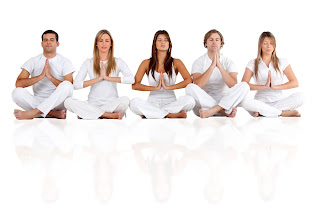Why Say Namaste?
Have you noticed that I say "Nasmaste" at the close of most of my Yoga classes? If so, do you say it too? Many students just parrot Namaste back as a matter of course, without knowing what it means. I know I used to way back when I worked up the courage to actually mumble Namaste in response to a teacher. That was, incidentally, a long time before I was confident enough to chant OM/AUM at any audible level.
Whether you say Namaste at the close of your yoga class is up to you, but I thought I'd give a brief overview of what it means to me, and why I say it.
As with a lot of things, you can find multiple meanings for the Sanskrit word Namaste. At its simplest, it is a greeting, to say hello. The word is made up of two Sanskrit words, with "Namaha" meaning "greetings" and "te" meaning "to you". Hence why Namaste is used by Indians multiple times a day.
In the ancient Vedic texts the word "Namaha" is said to mean "to bend", which is most likely where one of the common translations of "I bow to you" comes from. In fact, a lot of the time the Vedic reference of the word Namaste refers to bowing to a Divine being in particular.
Now, I am in no way claiming to be Divine, so I do not personally use Namaste to mean "The Divine in me bows to the Divine in you", like I was previously taught by a number of yoga teachers.
Some teachers and students of yoga choose not to say Namaste, for a range of reasons, including the fact that they believe it is a cultural appropriation, and being used incorrectly by Westerners.
With all this in mind, my current preference is to say Namaste at the close of a Yoga practice to say both "Thank you" and "I bow to you" to my students. My reason is that I am forever grateful to my students for sharing their yoga with me, and allowing me to learn from them; to be a better yoga teacher.



Comments
Post a Comment